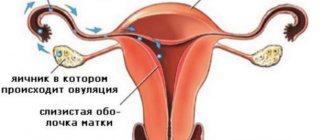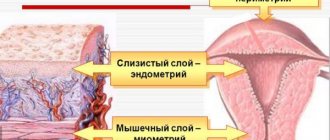During the menstrual cycle
, called the proliferative phase, the structure of the uterine mucosa has, in general terms, the character described above. This period begins shortly after the menstrual bleeding, and, as the name itself shows, during this period proliferative processes occur in the uterine mucosa, leading to the renewal of the functional part of the mucous membrane that was rejected during menstruation.
tissue proliferation
, preserved after menstruation in the remnants of the mucous membrane (that is, in the basal part), the formation of the lamina propria of the functional zone begins again. From the thin mucous layer preserved in the uterus after menstruation, the entire functional part is gradually restored, and, thanks to the proliferation of the glandular epithelium, the uterine glands also lengthen and enlarge; however, in the mucous membrane they still remain smooth.
The entire mucous membrane gradually thickens
, acquiring its normal structure and reaching an average height. At the end of the proliferative phase, cilia (kinocilia) of the surface epithelium of the mucous membrane disappear, and the glands prepare for secretion.
Simultaneously with the proliferation
During the menstrual cycle, the follicle and egg cell mature in the ovary. Follicular hormone (folliculin, estrin), secreted by the cells of the Graafian follicle, is a factor that determines proliferative processes in the uterine mucosa. At the end of the proliferation phase, ovulation occurs; In place of the follicle, the corpus luteum of menstruation begins to form.
His hormone
has a stimulating effect on the endometrium, causing changes that occur in the subsequent phase of the cycle. The proliferation phase begins on the 6th day of the menstrual cycle and continues until the 14-16th day inclusive (counting from the first day of menstrual bleeding).
We recommend watching the educational video: Mechanisms of the menstrual cycle - why does menstruation occur?
Secretion phase of the uterine cycle
Under the stimulating influence of the hormone
corpus luteum (progesterone), which meanwhile is formed in the ovary, the glands of the uterine mucosa begin to expand, especially in their basal sections, their bodies twist like a corkscrew, so that in longitudinal sections the internal configuration of their edges takes on a sawtooth, jagged appearance. A typical spongy layer of the mucous membrane appears, characterized by a spongy consistency.
The epithelium of the glands begins to secrete mucous secretion
, containing a significant amount of glycogen, which in this phase is also deposited in the bodies of glandular cells. From some connective tissue cells of the compact layer of the mucous membrane, enlarged polygonal cells with weakly stained cytoplasm and nucleus begin to form in the tissue of the lamina propria.
These cells are scattered throughout the tissue
singly or in the form of clusters, their cytoplasm also contains glycogen. These are the so-called decidual cells, which, in the event of pregnancy, multiply even more in the mucous membrane, so that their large number is a histological indicator of the initial phase of pregnancy (histological examination of pieces of the uterine mucosa obtained during chiretage - removal of the fertilized egg with a curette).
Conducting such a study
is of great importance especially when determining ectopic pregnancy. The fact is that changes in the mucous membrane of the uterus also occur in the case when a fertilized egg cell, or rather a young embryo, nidates (grafts) not in its normal place (in the mucous membrane of the uterus), but in some other place outside the uterus (ectopic pregnancy).
The inner layer of the uterus is called the endometrium. This fabric has a complex structural structure and a very important role. The reproductive functions of the body depend on the condition of the mucous membrane.
Every month throughout the cycle, the density, structure and size of the inner layer of the uterus changes. The proliferation phase is the very first stage of the natural transformations of the mucous membrane that begin. It is accompanied by active cell division and proliferation of the uterine layer.
The state of the proliferative endometrium directly depends on the intensity of division. Disturbances in this process lead to abnormal thickening of the resulting tissues. Too many cells have a negative impact on health and contribute to the development of serious diseases. Most often, when examined in women, glandular endometrial hyperplasia is detected. There are other, more dangerous diagnoses and conditions that require emergency medical attention.
Features of endometrial proliferation
For successful fertilization and a trouble-free pregnancy, cyclic changes in the uterus must correspond to normal values. In cases where an atypical structure of the endometrium is observed, pathological deviations are possible.
It is very difficult to find out about the unhealthy state of the uterine mucosa by symptoms and external manifestations. Doctors will help with this, but to make it easier to understand what endometrial proliferation is and how tissue proliferation affects health, it is necessary to understand the features of cyclical changes.
The endometrium consists of functional and basal layers. The latter consists of tightly adjacent cellular particles penetrated by numerous blood vessels. Its main function is to restore the functional layer, which, if fertilization fails, peels off and is excreted with the blood.
The uterus cleanses itself after menstruation, and the mucous membrane during this period has a smooth, thin, even structure.
The standard menstrual cycle is usually divided into 3 stages:
- Proliferation.
- Secretion.
- Bleeding (menstruation).
In this order of natural changes, proliferation comes first. The phase begins approximately on the 5th day of the cycle after the end of menstruation and lasts 14 days. During this period, cellular structures multiply through active division, which leads to tissue proliferation. The inner layer of the uterus can increase up to 16 mm. This is the normal structure of the endometrial layer of the proliferative type. This thickening helps to attach the embryo to the villi of the uterine layer, after which ovulation occurs, and the uterine mucosa enters the secretion phase in the endometrium.
https://youtu.be/XRLpzkrj8VQ
Causes of menstrual irregularities
It may happen that the menstrual cycle goes wrong and there may be several reasons for this:
- lack of normal ovulation mode – anovulation. What could be the impetus for this? Oncological diseases, formation of tumors or cysts; intestinal and gastrointestinal disorders - bulimia, anorexia on a nervous background; thyroid problems or Cushing's disease; PCOS, excessive exercise or ovarian failure;
- endometrial hyperplasia or polyp formation;
- problems on a hormonal background - the level of hormone regulators changes. The reason for this may be the incorrect selection of contraceptives or intrauterine devices. Perhaps the onset of early menopause, taking a large number of drugs that contain progesterone or other hormones;
- various inflammatory processes inside the uterus or genital organs, including sexually transmitted diseases;
- taking anticoagulants;
- diseases of the kidneys and the genitourinary system as a whole, intestines. Diabetes mellitus, or blood clotting problems.
Proliferative diseases
Intensive growth of the uterine layer during the proliferative phase occurs under the influence of hormones. Any disruption in this system prolongs the period of cell division activity. An excess of new tissue causes uterine cancer and the development of benign tumors. Background pathologies can provoke the occurrence of diseases. Among them:
Hyperactive cell division is observed in women with identified endocrine disorders, diabetes mellitus and hypertension. The condition and structure of the uterine mucosa are negatively affected by abortion, curettage, excess weight, and abuse of hormonal contraceptives.
Hyperplasia is most often diagnosed against the background of hormonal problems. The disease is accompanied by abnormal growth of the endometrial layer and has no age restrictions. The most dangerous periods are puberty and hyperplasia during menopause. In women under 35 years of age, the disease is rarely detected, since hormonal levels at this age are stable.
Endometrial hyperplasia has clinical signs: the cycle is disrupted, uterine bleeding is observed, and constant pain appears in the abdominal area. The danger of the disease is that the reverse development of the mucous membrane is disrupted. The size of the enlarged endometrium does not decrease. This leads to infertility, anemia, and cancer.
Depending on how effectively the late and early stages of proliferation occur, endometrial hyperplasia can be atypical and glandular.
Glandular hyperplasia of the endometrium
High activity of proliferative processes and intensive cell division increases the volume and structure of the uterine mucosa. With pathological growth and thickening of glandular tissues, doctors diagnose glandular hyperplasia. The main reason for the development of the disease is hormonal disorders.
There are no typical symptoms for glandular hyperplasia. The symptoms that appear are characteristic of many gynecological diseases. Most women's complaints are related to conditions during menstruation and after menstruation. The cycle changes and is different from previous ones. Heavy bleeding is painful and contains clots. Often discharge occurs outside the cycle, which leads to anemia. Serious blood loss causes weakness, dizziness and weight loss.
The peculiarity of this form of endometrial hyperplasia is that the newly formed particles do not divide. The pathology rarely transforms into a malignant tumor. Nevertheless, this type of disease is characterized by indomitable growth and loss of function typical of tumor formations.
Atypical
Atypical hyperplasia refers to intrauterine diseases that are associated with hypoplastic processes of the endometrium. The disease is mainly detected in women after 45 years of age. In every third out of 100, the pathology develops into a malignant tumor.
In most cases, this type of hyperplasia develops due to hormonal disruptions that activate proliferation. Uncontrolled division of cells with a disrupted structure leads to the growth of the uterine layer. In atypical hyperplasia, there is no secretory phase, as the size and thickness of the endometrium continues to grow. This leads to long, painful and heavy periods.
Severe atypia is a dangerous condition of the endometrium. Not only does active cell proliferation occur, the structure and structure of the nuclear epithelium changes.
Atypical hyperplasia can develop in the basal, functional, and simultaneously in both layers of the mucosa. The last option is considered the most severe, since there is a high probability of developing cancer.
External manifestations of the menstrual cycle
What symptoms are typical for menstruation?
- blood discharge of the corresponding color and consistency from the genital tract;
- an increase in size and “swelling” of the breast, possible painful sensations during palpation;
- bad mood, irritability, reluctance to communicate and even depression.
There are other characteristic signs, but they are absolutely individual and are not considered the norm for everyone. A normal and timely period of menstruation is the key to a woman’s health and readiness to bear and give birth to a child. If you have problems with menstruation, their duration or abundance, gynecologists recommend not putting the problem off for later and seeking medical help in a timely manner.
Duration of the menstrual cycle
With a normal menstrual cycle in a healthy woman, the duration of menstruation varies from 3 to 7 days. The time frame of the cycle is determined only by the girl’s state of health and the course of natural internal physiological processes.
Pain during the menstrual cycle
According to statistics, only 25% of all girls and women endure menstruation calmly and painlessly, without taking painkillers and doing their usual things. The remaining 75% actively apply cold heating pads, swallow pills and wince from the unpleasant sensations.
Doctors even introduced a new term that gives a medical designation to this phenomenon - “algodismenorrhea.” The main criterion indicating the normal course of the process is that there is pain, but it is tolerable, without sharp and acute painful symptoms. If you can safely do your usual activities during your period, there is no need to worry.
Phases of endometrial proliferation
It is usually difficult for women to understand what the phases of endometrial proliferation are and how a violation of the sequence of stages is associated with health. Knowledge about the structure of the endometrium helps to understand the issue.
The mucosa consists of a ground substance, a glandular layer, connective tissue (stroma) and numerous blood vessels. From about the 5th day of the cycle, when proliferation begins, the structure of each of the components changes. The entire period lasts about 2 weeks and is divided into 3 phases: early, middle, late. Each stage of proliferation manifests itself differently and takes a certain time. The correct sequence is considered the norm. If at least one of the phases is absent or there is a malfunction in its course, the likelihood of pathologies developing in the lining inside the uterus is very high.
Early
The early stage of proliferation is days 1-7 of the cycle. The mucous membrane of the uterus during this period begins to gradually change and is characterized by the following structural transformations of tissue:
- the endometrium is lined with a cylindrical epithelial layer;
- blood vessels are straight;
- the glands are dense, thin, straight;
- cell nuclei have a rich red color and oval shape;
- the stroma is oblong, spindle-shaped.
- The thickness of the endometrium in the early proliferative phase is 2–3 mm.
Average
The middle stage of the proliferative endometrium is the shortest, usually on the 8th–10th day of the menstrual cycle. The shape of the uterus changes, noticeable changes occur in the shape and structure of other elements of the mucosa:
- the epithelial layer is lined with cylindrical cells;
- the kernels are pale;
- the glands are elongated and curved;
- connective tissue of loose structure;
- the thickness of the endometrium continues to grow and reaches 6–7 mm.
Late
On days 11–14 of the cycle (late stage), the cells inside the vagina increase in volume and swell. Significant changes occur in the uterine lining:
- the epithelial layer is high and multilayered;
- some of the glands elongate and have a wavy shape;
- the vascular network is tortuous;
- cell nuclei increase in size and have a rounded shape;
- the thickness of the endometrium in the late proliferative phase reaches 9–13 mm.
All of these stages are closely related to the secretion phase and must correspond to normal values.
What is the menstrual cycle?
What does the concept of “menstrual cycle” mean? This is a short calendar period of time that begins on the first day of menstruation and ends on the last. Menstruation is a natural process that occurs in every physically and psychologically healthy woman every month, not counting expectant mothers and women during lactation. This is how nature works: after an equal period of time, the body adjusts to a possible conception and prepares all the conditions for the most comfortable pregnancy.
The process starts from birth: when a girl is born, her ovaries already contain about 2 million eggs, which die over time, leaving about 400 thousand. Their number decreases towards puberty, when active puberty begins. During a cycle, only 1 egg remains active. A regular, healthy menstrual cycle is impossible without the active participation of the cerebral hemispheres and normal hormonal levels.
What is the scheme for starting the menstrual cycle and how does it work using an example? The correct and standard sequence of all actions characteristic of a normal cycle occurs thanks to the smooth functioning of the appendages (ovaries), the pituitary gland (namely the anterior lobe) and the hypothalamus.
The average cycle length is 28 days, but the female body is quite capricious and this process is individual for each. There may also be indicators from 21 to 35 days, which is also considered common. If the indicators go beyond the above limits, you should think about your health by consulting a doctor.
Treatment of the disease
Treatment of cancerous pathology of the uterine body is prescribed individually, depending on the stage and form of the disease, as well as the age and general condition of the woman.
Conservative therapy is used only in the initial stages. Women of reproductive age with diagnosed stage 1–2 disease undergo hormonal therapy. During the course of treatment you need to undergo regular tests. This is how doctors monitor the state of the cell nucleus, changes in the structure of the uterine mucosa and the dynamics of the development of the disease.
The most effective method is considered to be removal of the affected uterus (partial or complete). To eliminate single pathological cells after surgery, a course of radiation or chemical therapy is prescribed. In cases of rapid growth of the endometrium and rapid growth of a cancerous tumor, doctors remove the reproductive organ, ovaries and appendages.
With early diagnosis and timely treatment, any of the therapeutic methods gives positive results and increases the chances of recovery.
Normal indicators
The most important problem and deviation from the norm is the difference in the number of days of the average cycle length. For example, if this month it is 30 days, and next month it is 21, you need to seek help from a gynecologist. The permissible norm of deviations, which can be up to 3 days. If the discharge lasts more than a week, this is not the norm, especially if it is heavy. Most likely, there is a pathology that only a doctor can determine.
There are certain indicators that are considered to be a normal deviation from the norm:
- puberty. The body of a teenager is unpredictable and it is impossible to determine anything for sure. Failures are always possible, because reproductive function is just getting better. 13 – 15 years is the normal age for the established cycle of a teenage girl. But we must not forget about individuality!;
- stress, neuroses;
- excessively strict diets or fasting;
- Menopause is the end of the reproductive system.
What should you pay attention to?
At any age, it is very important to pay attention to the signals that your body gives in order to avoid serious complications. There are a number of reasons that indicate changes in a negative direction:
- strange discharge between menstruation should alert a woman - this indicates a possible disease of the genitourinary system;
- irregular cycle;
- too strong and frequent pain in the lower abdomen, which persists for a long time before and after menstruation;
- PMS is too pronounced, severe stress and neurosis;
- duration of menstruation - if the period exceeds a week.
Blood test for hormone levels during menstruation
If a hormonal imbalance occurs, it is recommended to undergo urgent tests to determine their quantity. Why is this necessary? To find out in the early stages about the occurrence of various pathologies that are dangerous to a woman’s health. Clinical indicators are checked when the appropriate days of the cycle arrive:
- LH – 2 – 5 days of the cycle;
- FSH – 3 – 5 days;
- 6 – 10 – testosterone level;
- from day 20 - progesterone and sometimes estradiol.
What rules should you follow before taking tests:
- you cannot eat before the test; your last meal should be no earlier than 8 hours ago;
- a doctor must give a referral for tests;
- do not have intimacy 24 hours before the test;
- do not take any medications (consult a doctor);
- don't be nervous, don't get overtired.
The analysis is taken for certain hormones, strictly as prescribed.
Why do you need a period diary?
In the modern world of gadgets and devices, there are many convenient menstrual calendars. Gynecologists strongly recommend that all young girls use such electronic (or not) diaries: it is convenient, simple and very useful, you don’t have to worry about the onset of the next period - the calendar will notify you of the onset of all three phases or a delay.
The diary will help you learn about all deviations from the norm and disorders that have occurred in the body. You can calculate ovulation, the end of your period. This is a real find for girls planning a pregnancy.
All you need to do is enter the data into the electronic application, and it will then automatically calculate all the necessary dates and make important notes. You can highlight the amount of bleeding, profuseness, well-being, unfavorable moments for conception and vice versa.











